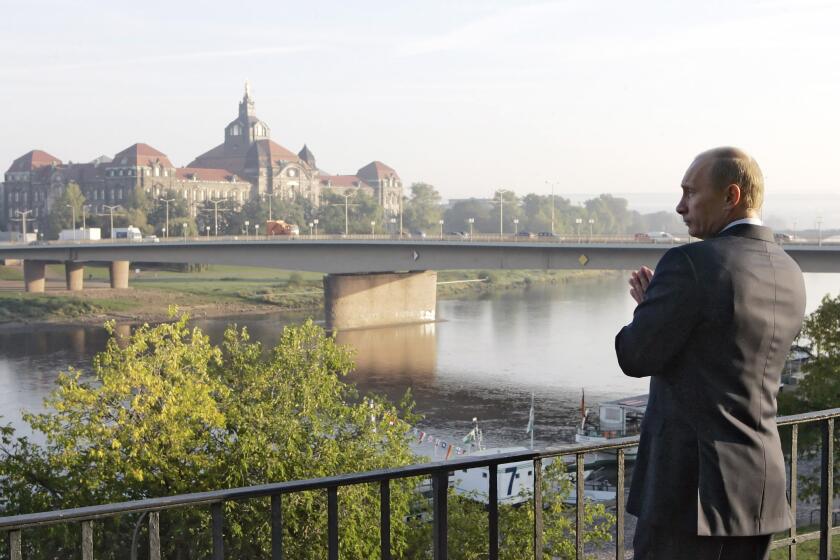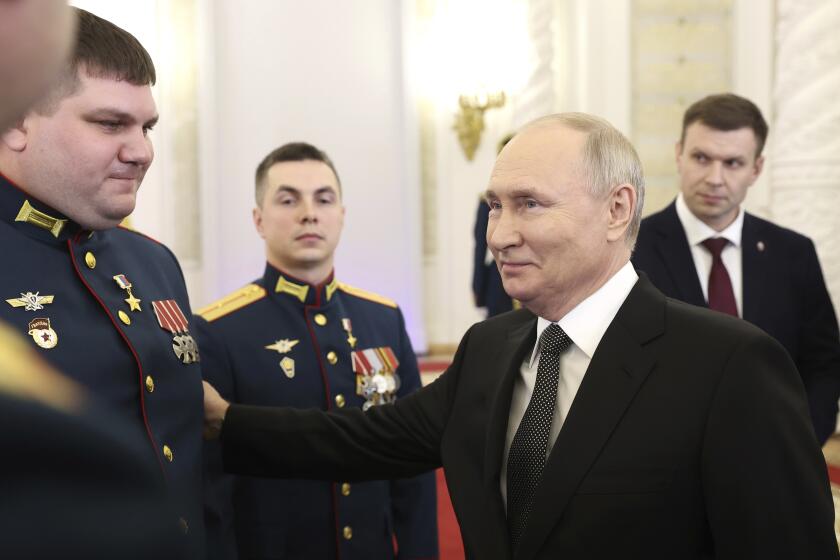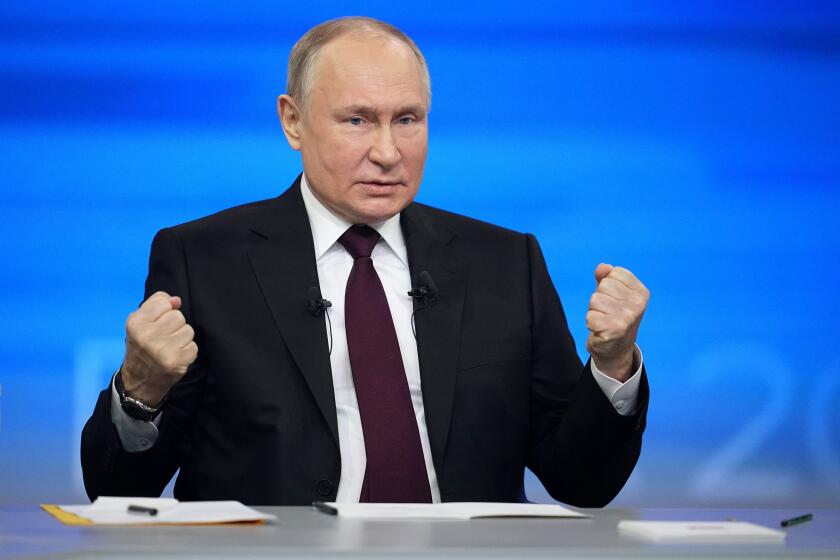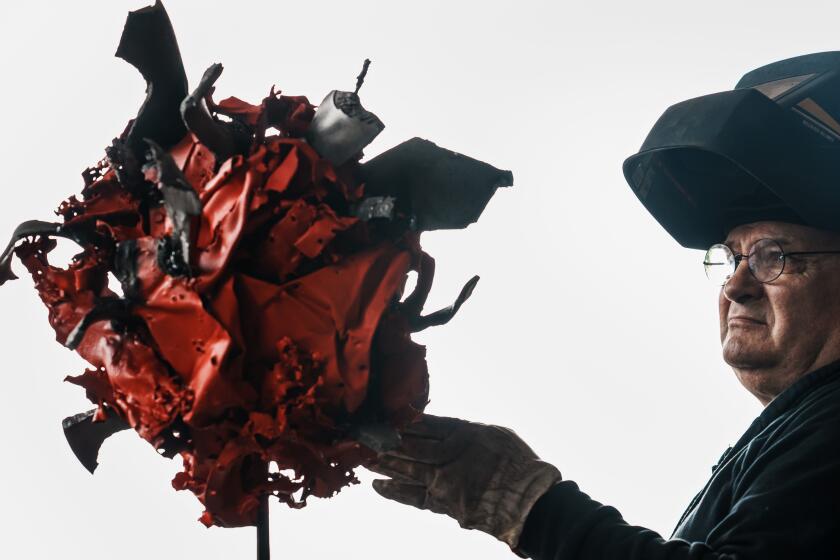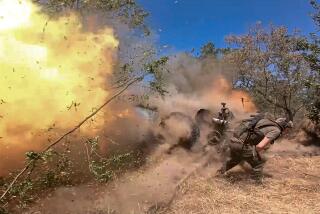Putin ratchets up military pressure on Ukraine as he expects Western support for Kyiv to dwindle
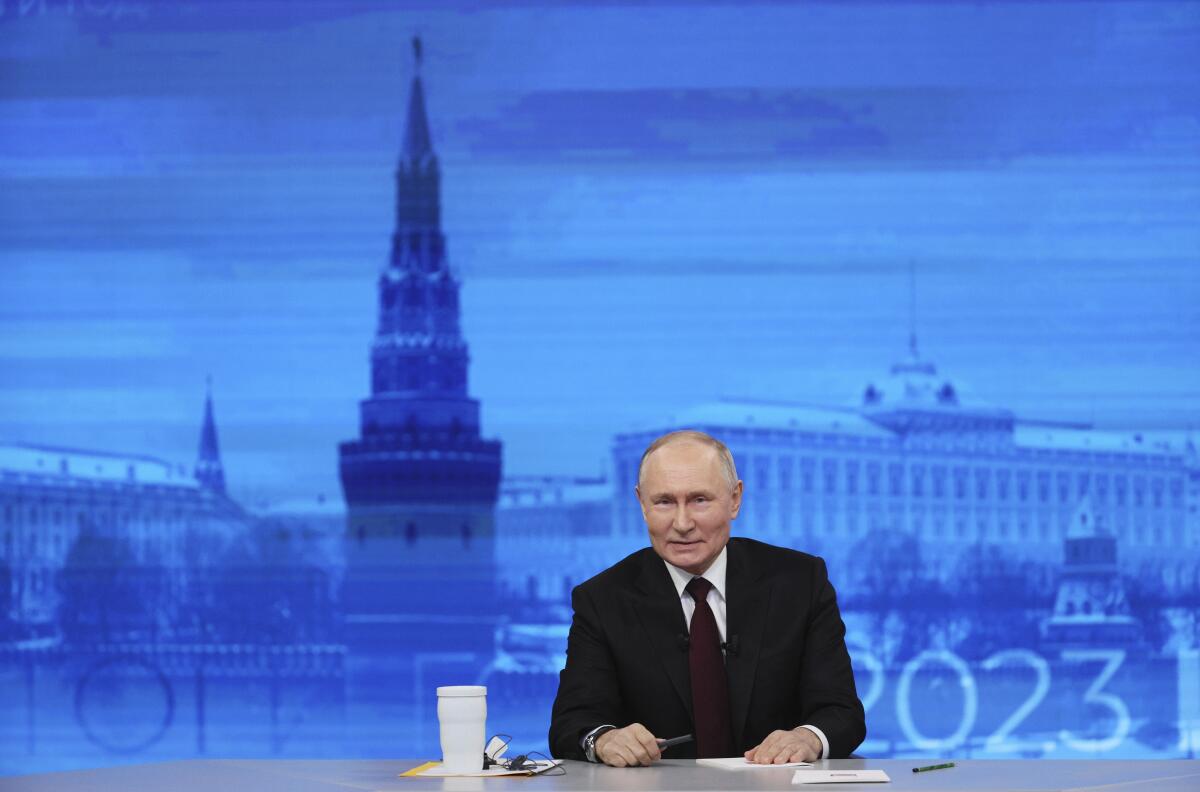
- Share via
After blunting Ukraine’s counteroffensive from the summer, Russia is building up its resources for a new stage of the war over the winter, which could involve trying to extend its gains in the east and deal significant blows to the country’s vital infrastructure.
Russian President Vladimir Putin seems to be hoping that relentless military pressure, combined with changing Western political dynamics and a global focus on the Israeli-Hamas war, will drain support for Ukraine in the nearly two-year-old war and force Kyiv to yield to Moscow’s demands.
“As far as the Russian leadership is concerned, the confrontation with the West has reached a turning point: The Ukrainian counteroffensive has failed, Russia is more confident than ever, and the cracks in Western solidarity are spreading,” said Tatiana Stanovaya, senior fellow with Carnegie Russia Eurasia Center, in a recent analysis.
An aid package for Ukraine has stalled in the U.S. Congress as Republicans insist on linking any more money to U.S.-Mexico border security changes opposed by Democrats. The European Union last week failed to agree on a $54-billion package in financial help that Ukraine desperately needs.
Amid these signs of fraying Western support, Russia has ramped up its pressure on Ukrainian forces on several parts of the more than 620-mile front line.
“The Russian military since October has been trying to seize initiative across the front in a couple of areas,” said Michael Kofman, a military expert with the Carnegie Endowment.
Ukraine’s military needs to reconstitute and regenerate its combat effectiveness after a grueling five-month counteroffensive, he said.
Russian President Vladimir Putin’s KGB years in East Germany offer a window into his crackdown on protests, war on Ukraine and yearning for empire.
Vladimir Putin aims to prolong his repressive grip on Russia for at least six more years through a presidential election he is all but certain to win.
“Ukrainian forces, while motivated, are exhausted,” Kofman said in a recent podcast. “They’ve lost a lot of units of action. They’ve lost a lot of assault capable troops.”
One area where Russia has maintained steady pressure is the northeastern city of Kupiansk, a strategically important rail hub that Moscow captured early in the war and then lost in a Ukrainian counteroffensive in September 2022. While Russian forces have failed to make gains in the area, Ukraine has had to maintain a significant force to protect the city.
Starting in early October, Russian troops also have launched an offensive around Avdiivka, a town near Donetsk, the center of the region that was seized by Moscow-backed rebels in 2014 and illegally annexed by Russia in 2022 with three other Ukrainian regions.
Ukraine has built multiple defenses in Avdiivka, complete with concrete fortifications and a web of underground tunnels, allowing them to repel fierce Russian attacks. Despite massive losses, Russian troops have inched forward steadily, seeking to envelop Avdiivka and cut Ukrainian supply lines.
That battle has evolved into a gruesome grind for both parties and has been compared to the fighting for Bakhmut, the war’s longest and bloodiest battle that ended with Russia capturing it in May.
The Kremlin and the Russian Defense Ministry are silent about specific plans, but some Russian war bloggers say Moscow could launch a massive offensive of its own to forge deep into Ukrainian territory.
Others warn, however, that the Russian military lacks resources for any big push, saying that would require many more troops and weapons, exposing it to the same risks that doomed initial Russian attempts to capture Kyiv and other cities in the northeast at the start of the war.
Russian President Vladimir Putin continues to vow that there will be no peace in Ukraine until his goals, which remain unchanged, are achieved.
In that botched attack, Russian armored convoys stretched along highways leading to the capital, becoming easy prey for Ukrainian drones and artillery. Such setbacks forced the Kremlin to switch to a defensive strategy along the front line.
Putin is eager to show battlefield gains as he faces reelection in March. He said last week that Russia has 617,000 fighters in Ukraine, a number that many war bloggers see as far short of the kind of massive force needed to strike deep into Ukraine. President Volodymyr Zelensky says his ground forces number about 600,000.
Western observers are emphasizing the need for Ukraine to build fortified defenses like Russia has done to counter any potential big offensive by Moscow.
Ukraine’s president, Volodymyr Zelensky, talks about the winter campaign against Russia, the Israel-Hamas war, elections and domestic arms production.
“Ukrainians have painfully few reserves,” warned Mark Galeotti, head of Mayak Intelligence consultancy and a senior associate fellow at Royal United Services Institute in London.
If Moscow manages to break through Ukraine’s defensive lines, “Russian forces could then really wreak havoc on lines of communication, lines of supply, rear supply bases,” he said.
“In that context, it does make sense to allow fortification to make up for the lack of reserves,” Galeotti said in a recent podcast.
In recent months, the Russian military has reduced the use of its long-range air- and sea-launched cruise missiles in what has been widely interpreted as a sign of Moscow’s effort to build up stockpiles of such weapons to strike Ukraine’s power grid and other key infrastructure in winter, when it is most vulnerable due to high consumption.
At the same time, Russia has stepped up attacks on Kyiv and other regions with waves of Iranian-made Shahed exploding drones, in an apparent effort to deplete Ukrainian air defenses.
Last winter, Russian relentlessly pounded Ukraine’s energy grid, causing long blackouts but failing to knock out the electricity network that showed a high degree of resilience. Ukrainian officials have warned, however, that this winter could be even harder due to Russian strikes.
Russian attacks plunged Ukrainian cities into darkness last winter. War-weary citizens brace for more blackouts amid a rush to protect Ukraine’s electrical grid.
While the West has provided air defense systems to protect Kyiv and other key areas, it could be challenging for Ukraine to cope with massive missile attacks from different directions. Ukraine’s allies also promised it a few dozen U.S.-made F-16 fighter jets, and Ukrainian pilots are training in Romania, but it’s unclear when the warplanes will arrive.
NATO Secretary-General Jens Stoltenberg has said the F-16s will strengthen Ukraine’s air defenses but noted, “There is not a silver bullet, not a single system that by itself will change fundamentally the situation on the battlefield.”
“We must not underestimate Russia,” he said. “Russia’s economy is on a war footing.”
While the West faced problems in maintaining the tempo of weapons supplies, with military aid hitting snags in Washington and Brussels, Russia has been increasingly boosting production of missiles, tanks and other weapons. The U.S. has said that Moscow also has started getting munitions under a deal struck with North Korea in September.
The Russian military has fixed many of its weaknesses and deficiencies that plagued it early in the war, and it has developed new weapons and tactics that helped derail Ukraine’s counteroffensive. A key factor that effectively paralyzed attempts by Kyiv to attack with a big mechanized force during the campaign was the sprawling minefields and other fortifications that Russia had built in the south.
One deadly novelty that significantly strengthened Russia’s military was converting Soviet-made dumb bombs into smart, gliding weapons equipped with winglets and a GPS system that allowed them to strike targets with precision far from the front.
This Ukrainian artist was known for whimsical sculptures. Now, amid Russia’s war on Ukraine, he creates art from war debris, military weapons and fury.
While Ukraine held a strong edge in drones at the start of the war, Russian forces since then have matched and even overwhelmed Ukrainian troops in using short-range small drones, which are now so prolific that Moscow is even pitting them against individual troops.
Kofman said that while Ukraine pioneered the use of drones, “Russia now has more of them and has an advantage in them.”
“Russia will be materially advantaged in 2024 in artillery ammunition, in production of drones and likely long-range drones and cruise missiles, too,” Kofman said. “If the West just assumes that it’s a stalemate and can reduce its commitment to Ukraine, Russian advantages will compound because Russia doesn’t accept the stalemate.”
More to Read
Sign up for Essential California
The most important California stories and recommendations in your inbox every morning.
You may occasionally receive promotional content from the Los Angeles Times.
